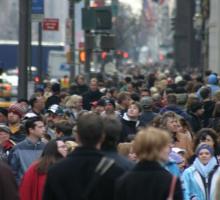- Behavioural Economics
- Ecological Economics
- Environmental Economics
- Health Economics
- Information Economics
- International Economics
- Labour Economics
- Monetary Economics
- Population Economics
- Public Finance
- Urban Economics
Microeconomics
In our daily lives, we face innumerable economic decisions, such as choosing what to buy with available money or what to do during our free time. These topics, which are related to the decisions of individual agents (individuals, families, businesses), are the object of study in an area of economics called microeconomics.
Macroeconomics
Another area of economics is macroeconomics, which studies the relationship between economic aggregates. Economic aggregates are elements that are made up of the sum of other variables. For instance, the Gross Domestic Product (GDP) is the sum of everything that is produced by each individual and organization within a country. The consumer price index is made up of the average price of numerous products. The aggregate investment is the sum of the expenditures in investment of all businesses and families of a country, etc.
Branches of Economics
Economics, in addition to the two perspectives already covered (macroeconomics and microeconomics), has many other branches, each one specializing in different objects of study. Thus, we have labor economics, which studies the labor market; public finances, which is dedicated to the study of the income and expenditures of the government; international economics, which studies the flow of resources between countries, etc.
The studies conducted by each of these sub-disciplines can take elements from both macroeconomics and microeconomics as well as from other social sciences such as history, psychology, etc., and from exact sciences such as logic and mathematics.
Branches of Economics
- Behavioural Economics: It studies the effects of social, psychological, cognitive, and emotional factors on the economic decisions. It uses mainly microeconomics.
- Ecological Economics: It studies the relation between the economy and the environment and how to achieve sustainable development.
- Environmental Economics: How natural resources are developed and managed. It uses mainly microeconomics.
- Health Economics: It studies the economy of the health and health care sector. Focused on microeconomics
- Information Economics: How information and information systems affect an economy and economic decisions. It uses mainly microeconomics.
- International Economics: How economic relations between countries, mainly trade, investment and labor flows, affect the economies. It can use microeconomics models, but is focused on macroeconomics aggregates.
- Labour Economics: It studies the labour (job) markets. It also uses a lot of tools from the microeconomics, but it can include macroeconomic analysis.
- Monetary Economics: It studies means of payments (money, etc.) markets.
- Population Economics: It studies demography using the tools of economics, and the relation between economy and population.
- Public Finance: It studies the role of the government in the economy: public spending, taxes, deficit, etc.
- Urban Economics: It applies the tools of economics to the study of cities: transit, housing, crime, etc.




